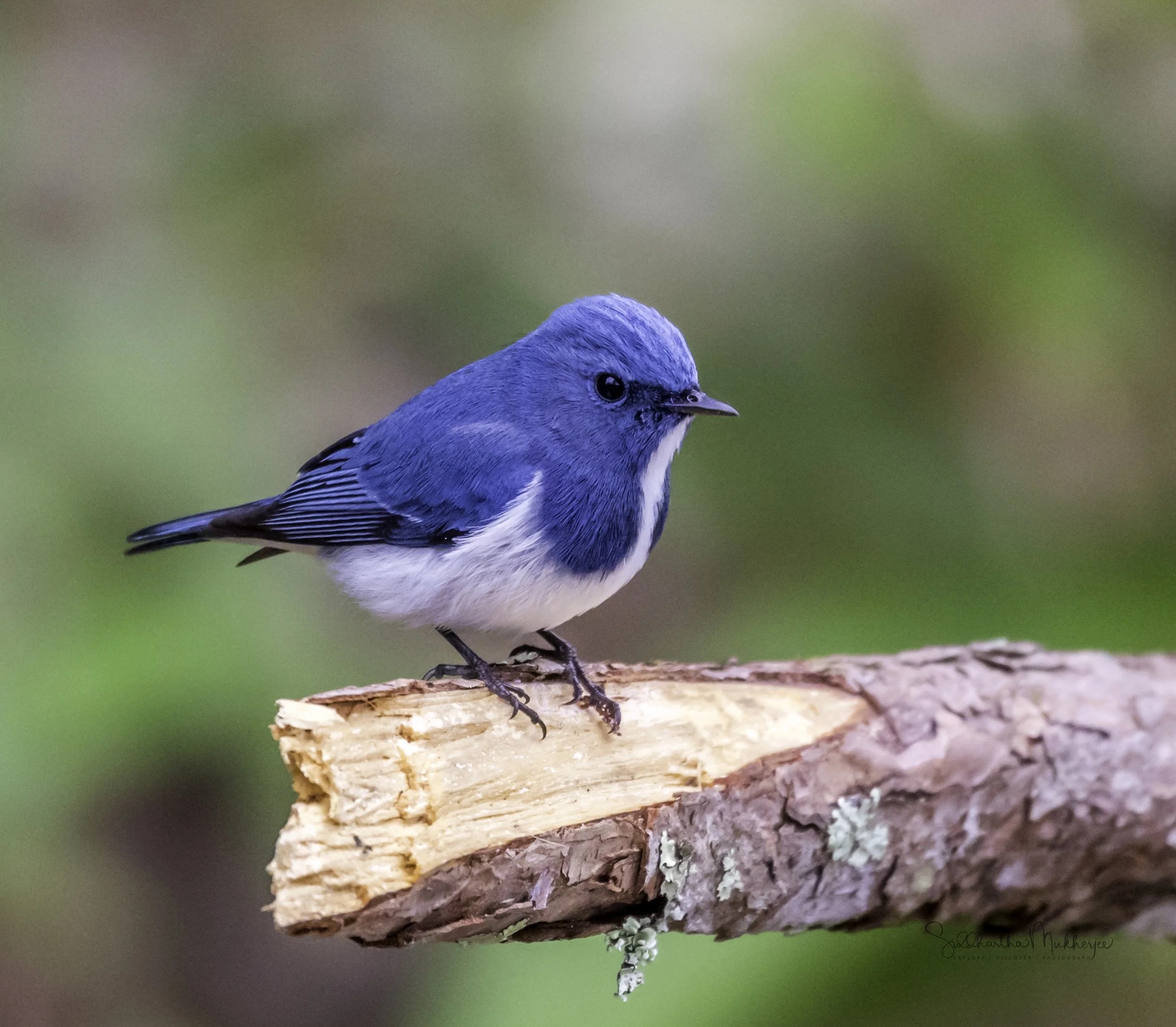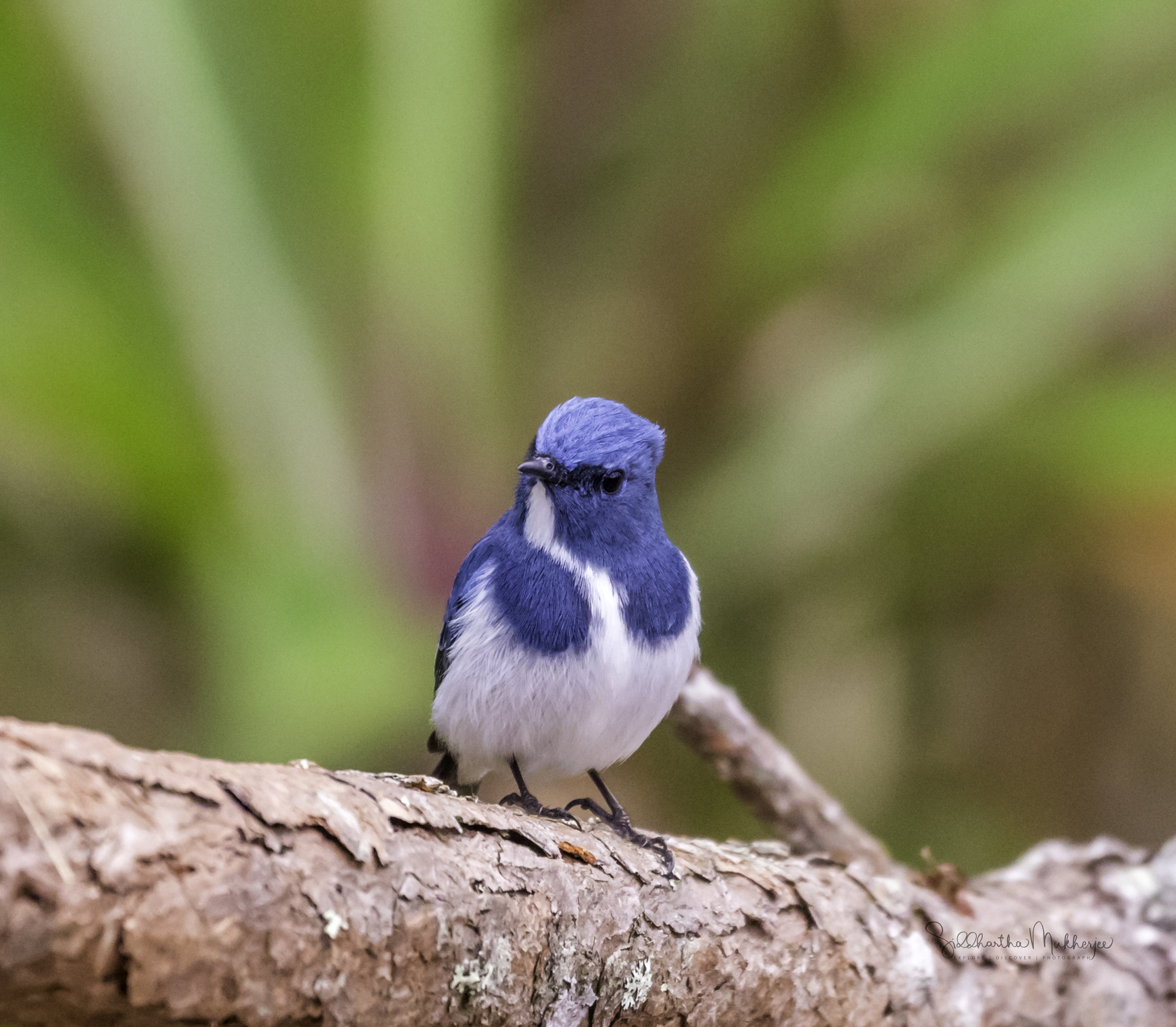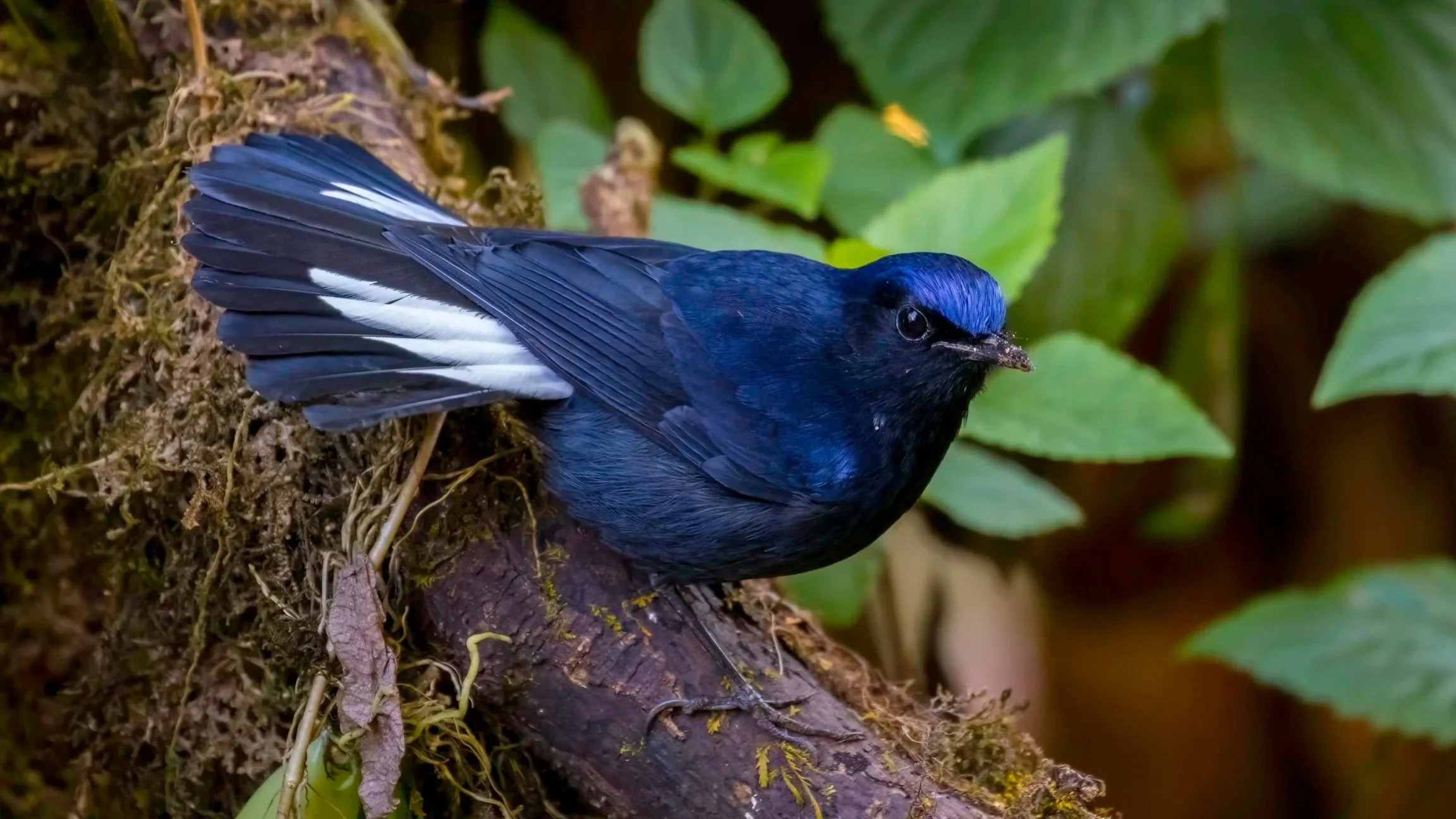Ultramarine Flycatcher
Ficedula superciliaris
Chiang Mai, Thailand
While I was writing up the Tickell’s Leaf Warbler I could not but help but wonder that I had still not written about the stunning Ultramarine Flycatcher - so here goes. This too was up on Doi AngKhang in the beautiful Chiang Mai district. The ultramarine or white-browed blue flycatcher is a small arboreal Old World flycatcher in the ficedula family that breeds in the foothills of the Himalayas & winters in southern India. The incandescently beautiful male is resplendent in electric blue and snowy white while the female is a dull gray-brown with paler underparts. It breeds in hill and montane broadleaf & pine forests descending into the lower foothills in winter.
The “Old World” - a fascinating term seemingly like something out of the Lord of the Rings and Jurassic Park put together. But in our case the term "Old World" is used commonly to refer to Asia, Africa and Europe (Afro-Eurasia or the World Island), regarded collectively as the part of the world known to its population before contact with the "New World" (the Americas). In the context of archaeology & world history, the term "Old World" includes those parts of the world which were in (indirect) cultural contact from the Bronze Age onwards, resulting in the parallel development of the early civilisations, mostly in the temperate zone between roughly the 45th and 25th parallels, in the area of the Mediterranean, Mesopotamia, Persian plateau, Indian subcontinent and China. The concept of the three continents in the Old World, viz. Asia, Africa, and Europe, goes back to classical antiquity. Their boundaries as defined by Ptolemy and other geographers of antiquity were drawn along the Nile in what is now Egypt and the Don river in Russia. This definition remained influential throughout the Middle Ages and the Early Modern period.
The Old World Flycatchers are a large family, the Muscicapidae, of small passerine birds mostly restricted to the Old World (Europe, Africa & Asia). These are mainly small arboreal insectivores, many of which, as the name implies, take their prey on the wing. The family includes 324 species & is divided into 51 genera. The name Muscicapa for the family was introduced by the Scottish naturalist John Fleming in 1822. The word had earlier been used for the genus Muscicapa by the French zoologist Mathurin Jacques Brisson in 1760. Muscicapa comes from the Latin musca meaning a fly and capere to catch. The appearance of these birds is very varied, but they mostly have weak songs and harsh calls. They are small to medium birds, ranging from 9 to 22 cm in length. Many species are a dull brown in colour, but the plumage of some can be much brighter, especially in the males. Most have broad, flattened bills suited to catching insects in flight, although the few ground-foraging species typically have finer bills. Old World flycatchers live in almost every environment with a suitable supply of trees, from dense forest to open scrub, and even the montane woodland of the Himalayas. The more northerly species migrate south in winter, ensuring a continuous diet of insects.
The family Muscicapidae contains many subfamilies and each sub family contains many tribes. I wrote about the genus Phoenicurus – Redstarts and the genus Myophonus - Whistling Thrushes in earlier blogs.
Featured here is the Ultramarine Flycatcher from Doi Angkhang and as is the norm in Thailand I have used a hide to get close. It has been a game of patience and perseverance and if one waits long enough the birds will come.
But first about where I first saw this resplendent flycatcher - the spectacular mountains of Northern Thailand. The Dois of northern Thailand have been very kind to me from a birding perspective. There are so many I have already talked about and so many still remaining. I have written an overview here on the Birds of the Dois and have now started to break them up into individuals like the Gray-backed Shrike, Long-tailed Shrike, Spectacled Barwing, Siberian Rubythroat, the stunning Mrs. Gould’s Sunbird and the numerous other birds I have seen here.
About 685 kilometers to the north of Bangkok lies the former seat of the ancient Lanna Kingdom and is considered one of the most scenic provinces in the country given its mountain ranges, valleys, flora and fauna. A land of misty mountains and colourful hill tribes, a playground for seasoned travellers, and a delight for adventurers. Despite its relatively small size and blissful calm, Chiang Mai truly has it all, a city that is still firmly Thai in its atmosphere and attitude. It is the second-largest changwat (province) of Thailand. Bordered by Chiang Rai to the northeast, Lampang and Lamphun to the south, Tak to the southwest, Mae Hong Son to the west and the Shan State of Myanmar to the north. Located in a verdant valley on the banks of the Ping River, Chiang Mai was founded in 1296 as the capital of the ancient Lanna Kingdom. Today it is a place where past and the present seamlessly merge with modern buildings standing side by side with venerable temples. Of all the places I have visited in Thailand, Chiang Mai with its forests and mountains and the historic city of Ayutthaya are by far my favourites.
The word Chiang itself is from North Thai, or Lanna, meaning town or city and Mai means new making Chiang Mai the New City as it was founded later than Chiang Rai, the earlier capital of King Meng Rai. The districts in the province are called amphoe, and sub-districts are called tambon. Another twist is the use of Nakhon (or Nakorn or Nakhorn), derived from the Sanskrit word Nagara, also means city, though strictly speaking it refers to a capital city such as Nakorn Sri Ayutthaya (more on Ayutthaya later). Indeed to emphasise its former status you may sometimes see Chiang Mai referred to as Nakhon Ping. Other common names of geographical features include mae (river) and doi which is north Thai for mountain - for example Doi Inthanon and Mae Ping.
The four Dois we spent our time on were Doi Inthanon, Doi Ang Khang, Doi Luang and Doi SanJu.
Doi Ankhang is a mountain belonging to the Himalayan foot hill range, located at the Myanmar (Burmese) border. The highest point is 1,928 metres. Although chiefly deforested, this is still one of Northern Thailand’s most prominent bird watching areas, due to more and rarer bird species being in residence, as well as being a popular resting point for numerous migratory birds. Examples of rare and beautiful birds inhabiting this area include the Mountain Bamboo Partridge, Spot-breasted Parrotbill, Tickell’s Leaf Warbler and the Red-faced Liocichla. It is not so uncommon to spot the Red-tailed Laughing Thrush here. Around The Royal Agricultural Project Station you can find Brown, Burmese and Long-tailed Shrike and also Fire-capped Tits and Silver-eared Mesia, White – tailed Robin & Maroon Oriole.
We didn’t have the good fortune to see all the species on all the mountains, that would have been impossible, but we did rack up quite a number of species - about 95 of them.
The beautiful road to the top of Doi Angkhang.
Read about the other birds from these beautiful mountains. These are only a few of the huge number I have spotted and recorded there.
With that said, meet this incandescently beautiful flycatcher from the mountains of Chiang Mai.
‡‡‡‡‡
Ultramarine Flycatcher
The ultramarine flycatcher or the white-browed blue flycatcher (Ficedula superciliaris ) is a small arboreal Old World flycatcher in the ficedula family that breeds in the foothills of the Himalayas and winters in southern India. Somewhat smaller in size than a sparrow (ca. 10 cm) and with a stocky build, the male is deep blue above with the sides of head and neck deep blue, & a prominent white patch running from the centre of the throat, through breast to belly. The amount of white on the brow and tail show clinal variation from West to East along the Himalayan foothills, which is sometimes taken to distinguish three subspecies:
Supercilium – also commonly referred to as “eyebrow” — is a stripe which starts above the bird’s loral area (area between beak and eyes), continuing above the eye, & finishing somewhere towards the rear of the bird’s head.
Where a stripe is present only above the lores, and does not continue behind the eye, it is called a supraloral stripe or simply supraloral.
The Supercilium is distinct from the eyestripe which is a line running across the lores, and continuing behind the eye.
The western subspecies from the western Himalayas has a distinctive white supercilium and white bases to the outer tail feathers.
The eastern subspecies (Ficedula superciliaris aestigma) from the eastern Himalayas lacks distinct white patches.
The population from the south Assam hills (sometimes designated a third subspecies cleta) completely lack any supercilium.
They’re spotted usually singly, though sometimes in mixed hunting parties. In the winter they keep largely to the low trees and bushes, feeding among the foliage canopy, not venturing much into the open. It constantly jerks up its tail, often accompanied by fluffing of head feathers and a ‘trrr’ note, especially in proximity of the nest. Their diet is mainly insects.
In the summer they are a common breeding visitor to the western Himalayas, from Jammu and Kashmir and Himachal Pradesh to Uttarakhand (western race), and intergrading within Nepal with the eastern race Ficedula superciliaris aestigma which continues in the eastern Himalayas through Bhutan to Arunachal Pradesh. Breeding between 2000 and 2700 m, occasionally as low as 1800 m and as high as 3200 m. Also in the lower hills of Meghalaya and Nagaland, Khasi & Cachar hills, sometimes considered a third race; winter movements of this population are not known. Their habitat is open, mixed forests of oak, rhododendron, pine, fir, etc., occasionally orchards.
In the winter they’re spotted in central India from Delhi south to northern Maharashtra, Goa, and eastward to Andhra Pradesh and Odisha. Wintering populations in the eastern states, possibly from Nepal/Sikkim, are mixed: a good part of this population also have a white supercilium and basal tail patches. Also sometimes found as a vagrant in the northern part of Bangladesh.
They nest from the middle of April to early July. Their nest is a soft structure of fine moss with some strips of bark and fine grass, lined with hair and rootlets, placed in holes or clefts in trees, at heights up to seven meters, or in a depression on a steep bank. Readily takes to nest boxes in hill station gardens.
They lay 3 to 5 eggs, usually 4, which are an olive greenish to dull stone-buff, densely freckled all over with reddish brown, or in another type, mostly around the large end, forming a cap.
It was a very pleasant morning with a nice breeze and beautiful diffused light. The conditions were perfect for photography and gradually as we settled into our hides a number of birds came out to forage. Towards the end of the bird wave the Ultramarine came out in a brilliant flash of blue. It came and perched very close to where I was hidden filling my frame allowing for some spectacular photos that I have showcased in the gallery below.
‡‡‡‡‡
Related Posts





























